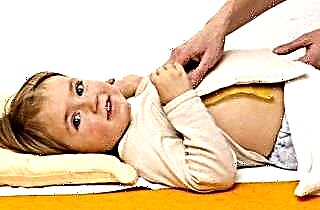Many parents ask the question of what is tubo-otitis in children and how to treat it, as well as whether there are any features of the course of this disease in a child and how to diagnose it in time. This question arises for a reason - tubo-otitis in a child can be almost asymptomatic and it is not easy to detect it at the initial stage. Therefore, it is so important to understand when there is a risk of developing this disease, and what preventive measures can be taken to prevent it.
Where does it come from
 The eustachian tube is a small and very narrow canal (about 2 mm wide) that connects the nasopharynx and the middle ear cavity. Its walls are lined with a delicate mucous membrane. When it becomes inflamed under the influence of external or internal factors, the disease is diagnosed with tubo-otitis in a child or adult. The inflammatory process can be acute or chronic.
The eustachian tube is a small and very narrow canal (about 2 mm wide) that connects the nasopharynx and the middle ear cavity. Its walls are lined with a delicate mucous membrane. When it becomes inflamed under the influence of external or internal factors, the disease is diagnosed with tubo-otitis in a child or adult. The inflammatory process can be acute or chronic.
Eustachitis occurs more frequently in children than in adults. Especially if the child is attending school or kindergarten. Usually, fungi, viruses and other pathogenic microorganisms penetrate into the cavity of the auditory tube from the nasopharynx. Much less often - through the holes in the eardrum during inflammatory processes in the outer ear or mechanical damage. In systemic diseases, the infection can enter through the blood or lymph.
Often, tubo-otitis in children is accompanied by diseases such as:
- SARS and flu;
- measles, chickenpox, rubella;
- purulent sore throat;
- sinusitis and sinusitis;
- pharyngitis, etc.

The Eustachian tube can also become inflamed if you blow your nose incorrectly - if the child blows out air through two nostrils at once. Often, bilateral eustachitis develops in children who swim or often bathe in open water - fungi and microbes from the water enter the oral cavity, and then through the nasopharynx into the ears.
Congenital or acquired curvature of the nasal septum can put pressure on the walls of the ear canal and provoke an inflammatory process. It also becomes the reason for incomplete cleansing of the mucus from the nose with a runny nose, in which microbes accumulate and actively multiply.
 Another common reason for the development of tubo-otitis is allergic reactions, which are accompanied by edema. When swelling occurs, the thin Eustachian tube is partially or completely blocked, and the air from the outside begins to press on the eardrum, causing it to constant tension, which can cause pain and provoke inflammation.
Another common reason for the development of tubo-otitis is allergic reactions, which are accompanied by edema. When swelling occurs, the thin Eustachian tube is partially or completely blocked, and the air from the outside begins to press on the eardrum, causing it to constant tension, which can cause pain and provoke inflammation.
In addition, a child's Eustachian tube is almost half as long as that of an adult and is almost straight, so it is much easier for infections to penetrate deeper.
In general, the causes of bilateral tubo-otitis in children and adults are practically the same. The only difference is that in a child it develops much faster, and if untreated, it can lead to more serious complications.
Childhood symptoms
 The first symptom of tubo-otitis in adults is tinnitus. The child may not pay attention to this or not understand how to explain this phenomenon to the parents. The second important symptom is a decrease in the auditory threshold, which an adult notices almost immediately, but a child does not. Also, tubo-otitis is often accompanied by a feeling of congestion, dizziness, and discharge from the ear.
The first symptom of tubo-otitis in adults is tinnitus. The child may not pay attention to this or not understand how to explain this phenomenon to the parents. The second important symptom is a decrease in the auditory threshold, which an adult notices almost immediately, but a child does not. Also, tubo-otitis is often accompanied by a feeling of congestion, dizziness, and discharge from the ear.
Therefore, if a child has a severe runny nose, he is sick or has recently been ill with one of the above diseases that can provoke tubo-otitis in children, parents need to be especially careful.
It is necessary to show the child to the doctor, even if he does not complain of ear pain, but the following changes are noticed in his behavior:
- increased irritability or drowsiness;
- he often scratches or touches his ears with his hands;
- small rashes appeared on the auricle;
- a greenish or yellowish fluid oozes from the ear;
- the child constantly asks again;
 stops responding to the call and his name;
stops responding to the call and his name;- shakes the head or tilts it on its side.
It must be remembered that an increase in body temperature at the initial stage of the disease does not always happen. The presence of one or two of the symptoms listed above is already quite a sufficient reason for contacting a medical institution. If, after examination, the doctor diagnoses tubo-otitis in a child, treatment should be started immediately and strictly follow all instructions.
Bilateral tubo-otitis occurs rarely in children. It usually develops if left untreated, when the infection spreads from one ear to the other.
The only way out in this case is active treatment with antimicrobial drugs, since bilateral inflammation is very painful and can cause meningitis.
Treatment features
 At an early stage of the disease, treatment of tubo-otitis in children is usually carried out without the use of antibiotics. Anti-inflammatory drugs and vasoconstrictor drops are quite capable of handling it, which help to increase the lumen and quickly relieve puffiness. Well-proven folk remedies such as warming up with a blue lamp, paraffin therapy, instillation with tinctures of eucalyptus, celandine, calendula help well.
At an early stage of the disease, treatment of tubo-otitis in children is usually carried out without the use of antibiotics. Anti-inflammatory drugs and vasoconstrictor drops are quite capable of handling it, which help to increase the lumen and quickly relieve puffiness. Well-proven folk remedies such as warming up with a blue lamp, paraffin therapy, instillation with tinctures of eucalyptus, celandine, calendula help well.
But alternative methods of treatment can be used only with the permission of a doctor. In the event that pus has accumulated behind the eardrum, the child has an increased body temperature or the integrity of the eardrum is violated, such procedures are categorically contraindicated. Moreover, they can cause burns, severe pain, and heating contributes to the spread of infection.
If the disease has turned into purulent otitis media, the child may need to be hospitalized and treated with antibacterial drugs. When there is a lot of pus, and it causes inflammation and severe protrusion of the eardrum, the doctor may decide to puncture it. This allows you to quickly relieve pain and speed up the healing process.
 Many parents refuse this manipulation, believing that it will impair hearing. But this is absolutely not the case. The procedure is carried out under local anesthesia and is very fast.
Many parents refuse this manipulation, believing that it will impair hearing. But this is absolutely not the case. The procedure is carried out under local anesthesia and is very fast.
The eardrum completely heals in 3-4 days and the puncture does not affect the acuity of hearing. But if, under the pressure of pus, not perforation occurs, but a rupture of the membrane, then hearing can be restored only with the help of a complex operation.
At the stage of recovery, physiotherapy procedures are often included. It can be ultrasound, electrophoresis, pneumomassage of the Eustachian tube, ultraviolet irradiation. Correctly selected vitamin therapy also helps to recover faster.
It is very important to protect your ears from hypothermia and overheating. Care must be taken to ensure that no water gets into them. And it is imperative to go through the entire course of treatment to the end in order to avoid possible relapses.
Disease prevention
The main preventive measure for any ear diseases, including tubo-otitis, is proper and regular child care. In addition, you need to know and follow simple, but very effective rules that prevent the development of inflammatory processes in the ears:
 Do not allow your child to go outside without a headgear that completely covers their ears in cold, damp, windy weather.
Do not allow your child to go outside without a headgear that completely covers their ears in cold, damp, windy weather.- Never use cotton swabs, hairpins or other sharp objects to clean the external auditory canal.
- When swimming, especially in open water, make sure that no water gets into the child's mouth, and after water procedures, be sure to remove water from the ears with a cotton or gauze pad.
- For any colds and viral diseases accompanied by a runny nose, it is necessary to bury the nose, do inhalations and teach the baby to blow his nose correctly.
- Always have antihistamines on hand if the child is prone to severe allergic reactions.
And most importantly, at the first signs of tubo-otitis in a child, it is imperative to consult a doctor and in no case prescribe treatment on your own. Improper treatment can lead to such serious consequences as purulent otitis media, ruptured eardrum, hearing loss and even complete deafness.

 stops responding to the call and his name;
stops responding to the call and his name; Do not allow your child to go outside without a headgear that completely covers their ears in cold, damp, windy weather.
Do not allow your child to go outside without a headgear that completely covers their ears in cold, damp, windy weather.

